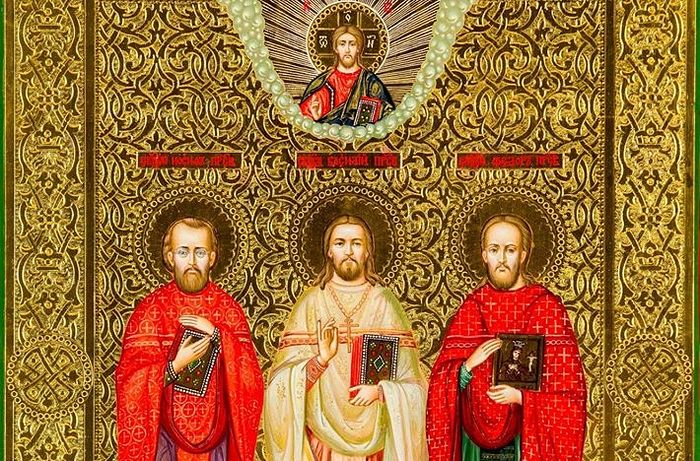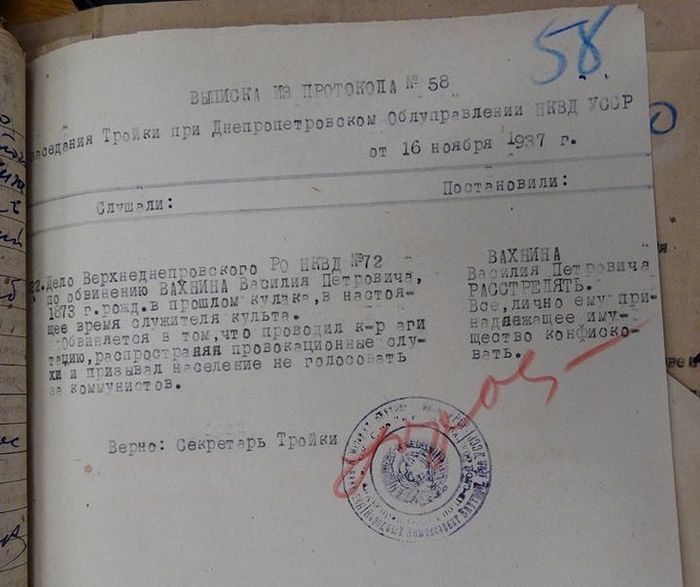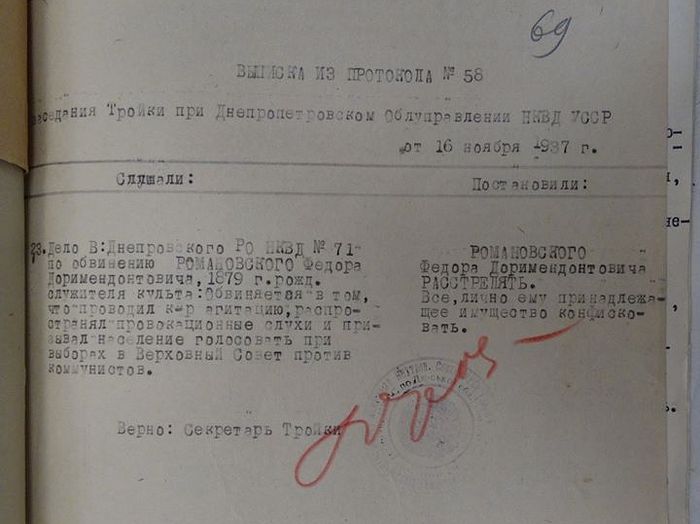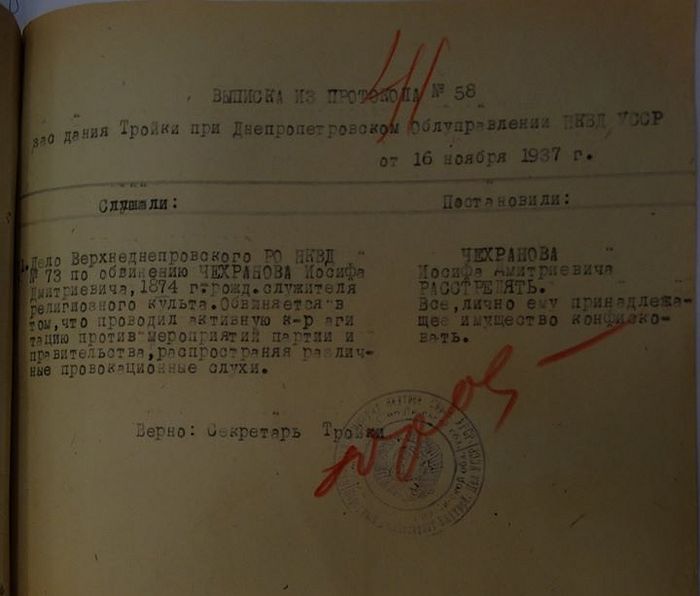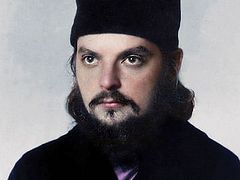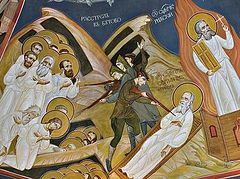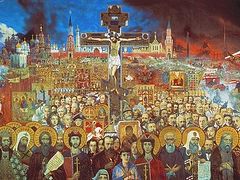On February 27, 2018, at a meeting of the Synodal Commission for the Canonization of Saints, the cases of three priests who were executed by the godless soviet authorities were examined and submitted to the Holy Synod for canonization. On March 18, 2020, the Holy Synod of the Ukrainian Orthodox Church canonized Hieromartyrs Vasily Vakhnin, Theodore Romanovsky, and Joseph Chekhranov, approving them for local veneration in the Kamensk Diocese.
As the three newly-glorified saints bore witness to Christ with their martyric deaths together, the ending details of their lives, including their conviction and execution, are provided in the final life, of St. Joseph Chekhranov.
Hieromartyr Vasily Vakhnin
Vasily Petrovich Vakhnin was born on March 3, 1873, in the village of Maksimlianovka in the Mariupol District of the Ekaterinoslav Governorate (now a village in the Marinka District of Donetsk Province) in the family of the priest Peter Vakhnin.
Vasily grew up as a pious boy and from his childhood his dream was to serve the Church. Moreover, from early childhood he considered it important to have an inner spiritual attitude and to be fully aware of himself at any given moment in life.
Seeing an example of worthy ministry, he desired to walk in his father’s footsteps. In 1891, he entered the Ekaterinoslav Theological Seminary, from which he graduated in 1897. At the request of his father, he was appointed by the ruling hierarch of the Ekaterinoslav Diocese as the reader at the Holy Spirit Church in his home village.
After his marriage to Evgenia Nikolaevna, he was ordained as a deacon by His Grace Bishop Simeon of Ekaterinoslav and Taganrog in the Holy Cross Church in Ekaterinoslav (the chapel in the bishop’s residence) and was sent to serve in the Annunciation Church in the main city of the governorate. On August 6, 1899, he was ordained as a priest by the same hierarch and sent to serve as rector of the St. Nicholas Church in the village of Pushkarevka in the Verkhnedniprovsk District (now the Verkhnedniprovsk District of the Dnipopetrovsk Province).
According to the tradition of that time, as the local priest of the Pushkarevka parish, on November 27, 1900, he was appointed as law teacher at the Pushkarevka People’s School.
Fr. Vasily was loved by his parishioners for his simplicity and charity. When one of them needed help, he gave it simply and without hesitation. He faithfully fulfilled the Church typikon, not allowing any abbreviations or deviations in the services, for which he enjoyed the respect not only of the parishioners, but also the hierarchs, and for which he was subsequently appointed dean. For his zealous labors and irreproachable ministry, Fr. Vasily was granted the following liturgical awards: in 1905, the right to wear the nabedrennik,1 and in 1912 the colored skufia.2
In 1918, the soviet authorities issued a decree on the separation of the Church from the state, similar to the anti-Christian edicts of the pagan emperors of Rome, the goal of which was to destroy the Orthodox Church. The soviets’ decree forbade any form of preaching, which entailed even the wearing of a priest’s cassock outside the church. In some places, priests were threatened to change their appearance and were killed for insubordination.
Under such severe conditions, the Pushkarevka priest continued to celebrate the services and preach the word of God. For this, Fr. Vasily was indicted for the first time, “for subversive work on a collective farm.”
In the early 1930s, the godless authorities closed the St. Nicholas Church in Pushkarevka, and in April 1936, the church was dismantled.
Fr. Vasily was very concerned in these terrible days and protested in every possible way, trying to stop the destruction of the church, threatening God’s punishment for such a sacrilege.
In 1936, a case was opened against Fr. Vasily concerning the issuing of birth, marriage, and death certificates. The NKVD District office was informed that the priest in Pushkarevka was issuing certificates such as: “The Pushkarevka peasant Emelian Timofeevich Zabaransky’s son Dmitry was born on September 4, 1920, No. 67. Vakhnin.”
He continued doing so as before, not considering it a crime. He was a priest and people constantly came to him with various issues. So here, he felt his responsibility and kept records and a registry.
He enjoyed great authority among his parishioners, many of whom visited him at home for advice. Fr. Vasily had a large library with many spiritual books that he would give to anyone who wanted to read them. He also provided assistance to suffering parishioners in the village.
At the NKVD investigator’s interrogations, Batiushka explained his actions: “I have in my apartment a book on the Pushkarevka parish, in which the church reader marked the years of birth of the parishioners from their own words… Additionally, I have kept my more accurate personal records of the year of birth of newborns, which I made during Baptisms from 1919 to 1935 inclusive, which I would give to students or their parents who came to me, so they could check it in the Pushkarevka Village Council metrical book and take an official certificate, without delay.”
Thus, after newly-formed civil registry offices seized the metrical books from the churches, the rector of the Pushkarevka parish continued to record the Sacraments he celebrated in his personal journal, on the basis of which he subsequently issued Baptismal records on separate sheets of paper at the request of the faithful. Considering this to be arbitrariness and an appropriation of the powers of the state structures, the NKVD fined Fr. Vasily 100 rubles [a considerable sum at that time—Trans.].
On September 27, 1937, on the feast of the Elevation of the Cross, the future hieromartyr was arrested by the NKVD, and thus began Fr. Vasily’s ascent upon his personal Golgotha, where, according to Sacred Scripture, a “death whereby he should glorify God” (cf. Jn. 21:19) awaited him.
The communist authorities brought the following fabricated charges against Fr. Vasily: “The investigation in the Vakhnin case established that Vakhnin, Vasily Petrovich has not worked anywhere for five years and is systematically engaged in counter-revolutionary activities, engaging in counter-revolutionary propaganda under the guise of religion… He intoxicates old farm women and attracts school children to himself, corrupting the latter in a counter-revolutionary spirit… In May 1937, Vakhnin threatened parents that their children shouldn’t wear the Pioneers’ tie, spreading provocative rumors that communists would soon be hanged… In July 1937, Vakhnin called on collective farmers to renounce the communists, declaring that it was going to rain immediately…”3
Echoing the punitive bodies of the godless authorities, the local village council slandered the priest and echoed all the false accusations and denunciations made against him…
Hieromartyr Theodore Romanovsky
Theodore Dorimedontovich Romanovsky was born on April 13, 1879, in the village of Gansk in the former Siedlce Governorate, to the family of the priest Dorimedont Romanovsky. He was the first-born in a family of seven children.
Desiring but one thing from childhood, he entered he Warsaw Theological School in 1889, from which he graduated in 1893. From 1893 to 1899, he completed the full course of the Kholm Theological Seminary.
He had a good ear and a beautiful voice and he helped his father on the kliros from childhood.
After receiving his spiritual education, he was appointed as psalmist at the Holy Dormition Church in the city of Grubeshov and as a teacher at the psalmists’ school at St. Onuphry-Yablochno men’s Monastery. It was the most interesting time for the young Theodore. Here he not only sang, but his soul sang and exulted.
Having become acquainted with the daughter of the priest Stephania Noskovic, he was married in 1901. He was ordained as a deacon on July 8, and as a priest later that same year. For six years, he carried out his priestly ministry as the rector in the village of Serochin in the municipality of Sterdyń; from 1907 to 1913 he served as priest in the village of Woskrzenice in the municipality of Biała Podlaska; and in 1915, he was transferred to the Cathedral of Sts. Cyril and Methodius in Biała Podlaska and appointed to teach the Law of God in the men’s school in the same city.
The First World War disrupted the Orthodox life of “Russian Poland.” In 1915, after the retreat of Russian troops from Biała Podlaska, the church was abandoned by the Orthodox priests. Together with other refugees, Fr. Theodore was evacuated to the Ekaterinoslav Governorate. On August 25 of that year, he was appointed as chaplain for the 228th Simferopol Reserve Infantry Regiment.
Recalling this time, he would point out that it was by God’s providence that he found himself in Ekaterinoslav.
In October 1916, when visiting the regiment in a cross procession with the Samara Icon of the Mother of God, the All-Night Vigil was served in the evening of October 24, during which Fr. Theodore delivered his bright homily on “the universal veneration of the Mother of God, from whom no one departs unheard.” The next day, following the Liturgy, a moleben was celebrated on the square in front of the church, with the entire 228th Reserve Regiment. Following the moleben and the sprinkling of the troops with holy water, a cross procession accompanied by the clergy, a choir, a band, and a mass of worshipers headed for the Cathedral of the Elevation of the Cross, where it was completed.
He took the revolution of 1917 implacably. After the decree on the seizure of Church valuables, Fr. Theodore said that he would not obey the lawless order, for which he was prosecuted by the soviet authorities in 1922 and was condemned to a year’s probation.
Then he served as the priest in Verkhnedniprovsk until 1931, after which he had no specific place of ministry, holding prayer meetings at his apartment, and often going to Pushkarevka to his dean, Fr. Vasily Vakhnin. He served in the morning and evening in his apartment on the territory of the Litvinovka Village Council (now Litvinovka—part of Verkhnedniprovsk).
He served in villages. By that time, the churches were already closed, and he served where he could. He celebrated the Sacraments and prayers, and it could be said that he never refused the requests of the faithful. In turn, the parishioners loved Fr. Theodore and tried to help him, but doing so secretively out of fear of the authorities.
He himself feared no one, but was courageous and steadfast in the faith.
In the spring and autumn of 1937, another offensive by the authorities against the Orthodox Church began. For the Verkhnedniprovsk District of the Dnipropetrovsk Region, this time proved to be the most brutal in terms of the persecution of the clergy…
Hieromartyr Joseph Chekhranov
Joseph Dmitrievich Chekhranov was born in 1874 in the village of Peshkovo in Rostov Country in the Ekaterinoslav Governorate (now the village of Peshkovo in the Azov District of the Rostov-on-Don Province) in the family of the priest Dmitry Chekhranov.
From childhood, he was brought up in the spirit of piety and love for the Church. He always saw a good example of Christian living in his family.
From 1890 to 1894 he studied at the Ekaterinoslav Theological Seminary, and from 1894 to 1898 at the Donskoy Theological Seminary in Novocherkassk. After graduating from the Donskoy Seminary, he was appointed as supervisor for students of the Ekaterinoslav Theological School, and from 1899 as a teacher of penmanship at the school.
After marrying Maria Alexandrovna, he was ordained as a deacon on July 8/21 in the Holy Cross Church in Ekaterinoslav (the chapel at the episcopal residence) by Bishop Simeon of Ekaterinoslav and Taganrog, on July 15/28, 1901 as a priest in the same church, and was appointed to the Church of the Nativity of the Theotokos in the village of Novo-Ekonomichesky in Bakhmut County.
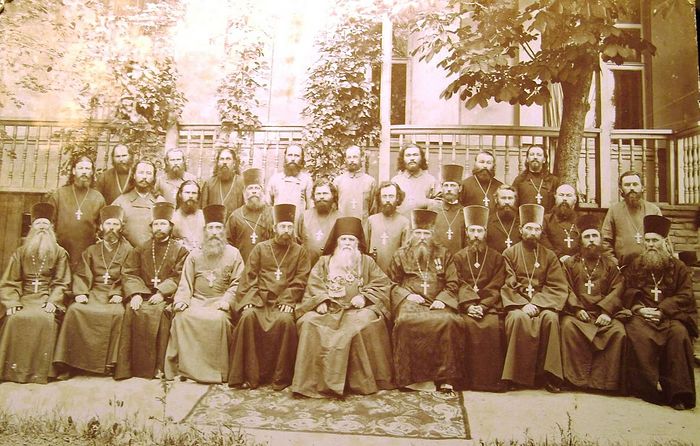 25th Diocesan Congress in Ekaterinoslav (today Dnieper), June 18-25, 1908. Hieromonk Joseph Chekhranov is 6th from the left in the second row
25th Diocesan Congress in Ekaterinoslav (today Dnieper), June 18-25, 1908. Hieromonk Joseph Chekhranov is 6th from the left in the second row
Having a good education and enjoying respect among the clergy and faithful, he served as the spiritual inspector of the Second District of Bakhmut County until 1907. On May 1, 1907, he was relocated to St. Vladimir’s Church in the village of Sophievka in Alexandrovka County, and on November 16 of the same year, he was transferred to Holy Dormition Cathedral in Verkhnedniprovsk, where he carried out his priestly ministry until the closing of the church.
For his zealous labors, he was awarded the purple skufia4 in 1913 by the ruling hierarch.
But the atheists came to power and the persecutions began. After the closure of the church in the early 1930s, he started holding meetings in his apartment in the neighboring village of Lenin.
Many people would come to him for advice, for spiritual support, or just to hear a good word.
Each of the hieromartyrs Vasily, Theodore, and Joseph was arrested on denunciation. They had been watching them for a long time, awaiting a convenient time to arrest them.
To fight against the clergy, the extended Presidium of the Pushkarevka Village Council was convened on September 23, 1937, resulting in a petition to the NKVD authorities to expel all clergy from Pushkarevka.
Here are some false testimonies against those who suffered for Christ:
“In April 1936, when they began to disassemble the Pushkarevka church, Vakhnin went to all the collective farmers, calling on them to protest so they won’t dismantle the church… Every day he goes to the houses of all the collective farmers, where he says that God doesn’t give any rain because you have renounced God, and if you don’t believe in God, we will starve to death.”
“The priest Romanovsky would say that the church will be rebuilt on the bones of the communists and those who dismantled it;” “If they listen to the communists, they will starve to death.” “I saw the priest Romanovsky systematically come to the territory of the Molotov artel5... He gathered collective farmers, carried out counter-revolutionary work, saying ‘Why do you go to work in the collective farms?... It’s better to ask the Lord God to take the communist demons away from us.’”
“Chekhranov6 arrived in Verkhnedniprovsk in 1907, where he served the whole time as the priest in the local church and in the former girls’ school… In his apartment he baptized children, served weddings, blessed…;” “On all religious holidays, he arranged prayers, services, he baptized children, and he took collective farmers away from working in the harvest.”
The authorities arrested the future witnesses for faith in Christ during the second half of September 1937: Fr. Theodore was arrested on the 19th, the punitive authorities came for Fr. Joseph on the 25th, and on the 27th, the feast of the Elevation of the Precious Cross, Fr. Vasily’s own ascent upon his personal Golgotha began.
The godless authorities accused the servants of the Church of being hostile towards the soviet system, of religious propaganda, and of corrupting school children and peasants.
Having sent the indictment documents to Dnipropetrovsk for consideration by the Special Troika of the NKVD, the Verkhnedniprovsk “guard of order” virtually sentenced the priests to death. The Troika’s decisions were concise and almost always ended in the highest possible degree of punishment—execution.
On the feast of the holy Great Marty George the Victorious, November 16, 1937, Frs. Vasily, Theodore, and Joseph were convicted by decision of the Troika and sentenced to death by firing squad.
On November 16, 1937, in Dnipropetrovsk was held a session of the Troika of the Provincial Administration of the NKVD of the Ukrainian Soviet Socialist Republic—or simply, the Special Troika. Cases were usually considered in absentia, with a minimum of documents, in haste—and what need was there for long proceedings when the battle against the enemies of the Motherland was in full swing?
Protocol No. 58 provides these dry lines on the three defendants, Vasily Petrovich Bakhnin, Theodore Dorimedontovich Romanovsky, and Joseph Dmitrievich Chekhranov: “Resolved: FIRING SQUAD. All personal property belonging to them shall be confiscated.”
On November 19, all three—Fr. Vasily, Fr. Theodore, and Fr. Joseph—were shot and buried in an unmarked common grave outside Dnipropetrovsk.
Translated from materials from the Historical-Archive Commission of the Kamensk Diocese
The life of St. Joseph Chekhranov is supplemented with material from drevo-info.ru.

